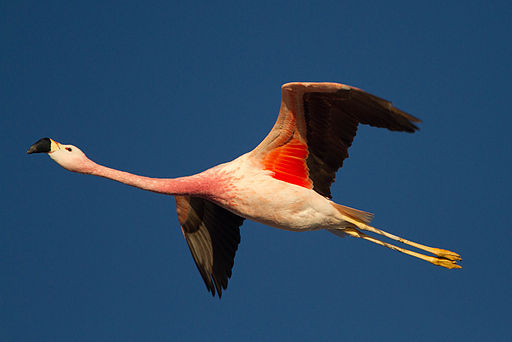 |
| Source: Copyright Trevor Rickard and licensed for reuse under this Creative Commons Licence |
The Andean flamingo is the rarest of the world's five species of flamingos. They belong to one of the oldest bird families which originated over 50 million years ago and are now threatened by the continuing exploitation and deterioration of their habitat. The Andean flamingo has show a decline equal to 24 percent in 15 years. Breeding success is consistently low and the adults live 50 years (therefore considered long-lived).
 |
| By Valerio Pillar (DSC_5251.JPG (DSC_5241 cropped)) [CC-BY-SA-2.0], via Wikimedia Commons |
They live on the puna. The puna is a high, cold, dry plateau in the Andes Mountains. These flamingos live in Peru, Argentina, Bolivia and Chile. The flamingos live in lakes where the water is ten times as salty as the sea. The lakes are home to diatoms which are microscopic single-cell algae which is what these flamingos eat. Like all the other flamingos, the Andean flamingo is an upside down filter feeder. (For more on feeding see my post here.) Here is a YouTube video of some Andean flamingos feeding Wildfowl and Wetlands Trust near Slimbridge, Gloucestershire, United Kingdom.
In the winter the Andean flamingos migrate to the lower wetlands. It is expected that this migration is due to the extreme aridity of the lakes in winter. (Source)
The species nest in only ten or so major colonies and the breeding sites are under increasing pressure. Away from regular colonies, the flamingos are still hunted for their meat, feathers and fat (used in traditional medicine). Most of the birds killed are juveniles. Some people also remove their eggs for personal consumption or to be sold. There have also been an increase in mining near the breeding colonies and the development of the mining industry and towns to support it are major threats. There is water pollution as well as water diversion which cause fluctuating water levels. (For more on breeding and the life of a chick see my post here.
 |
| Source: Arpingstone at Wikimedia Commons |
 |
| By Paulo Fassina (Flamingo Flying 2) [CC-BY-SA-2.0], via Wikimedia Commons |
I should note that only the greater flamingo is not considered threatened. Even with several million birds (all four species combined) they are threatened due to hunting, long breeding cycle and there are fewer than 30 major breeding sites in the world.
I'll be sharing this in the Multicultural Kid Blog Hispanic Heritage Blog Hop. Have you entered the amazing giveaway yet?























.svg.png)

